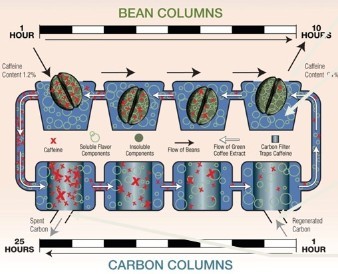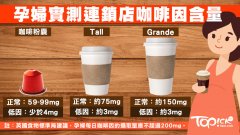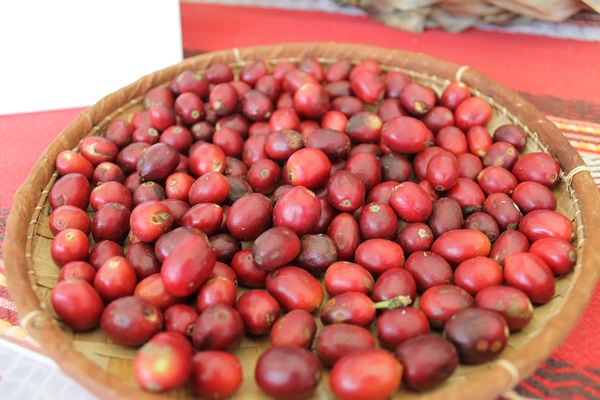What kind of coffee is low in caffeine? Recommend Colombian Swiss water treatment decaffeinated coffee beans

For professional baristas, please follow the coffee workshop (Wechat official account cafe_style)
Swiss Water treatment Act (The Swiss Water or Water-Only Process): the use of commercially developed and efficient treatment methods, there are two major steps. The first step is to pour the raw coffee beans into hot water, which will remove all the flavor factors in the raw coffee beans, including caffeine, and discard the original batch of raw coffee beans. After that, the hot water loaded with all the flavor factors is filtered out by an activated carbon filter, and the rest is hot water full of pure flavor factors, which is called "flavor filled water (Flavor-charged Water)" in Swiss water treatment. This water contains saturated coffee bean flavor factors, but lacks caffeine, followed by the most important medium in the decaffeination process.
A new batch of raw coffee beans soaked in water full of flavor factors and non-caffeine will release caffeine in raw coffee beans, but will not release flavor factors. In this way, the original flavor of raw coffee beans will not be much impaired. Obviously, the flavor factor in the flavor-loaded water is already close to saturation, so it can no longer dissolve more flavor factors, but there is still a lot of room to dissolve caffeine.
The treatment of low caffeine can be divided into three kinds: 1. Solvent extraction 2. Swiss Water treatment method 3. Carbon dioxide high pressure extraction.
Solvent extraction method
The coffee beans are softened first, then the bean surface is expanded by high-temperature and high-pressure steam heating to increase the contact area, and then the dichloromethane solvent is poured into the bean to contact with the solvent to extract caffeine. However, dichloromethane is a suspected carcinogen and harmful to the environment, and dichloromethane is currently banned from food processing in Taiwan.
Swiss water treatment method
After the coffee beans are soaked in warm water, after caffeine and other ingredients are dissolved in the water, the caffeine in the essence is filtered with activated carbon, and then the non-caffeinated essence is introduced into the previous coffee beans, allowing the beans to reabsorb the lost ingredients.
Carbon dioxide high pressure extraction
When roasting coffee beans, there is a large amount of carbon dioxide (CO2). At this time, the carbon dioxide is treated under high pressure to become liquid, and then poured into the processed coffee beans to remove caffeine, and then the pressure is released to convert the carbon dioxide into gas volatilization. This way of removing caffeine can retain more of the original flavor of coffee beans, but it requires a special high-pressure environment and requires a large amount of investment in equipment, which is rare in Taiwan.
Taste analysis: roasted hazelnuts, nuts, spiced rice, chocolate, caramel sweetness, soft acidity, body smooth
Important Notice :
前街咖啡 FrontStreet Coffee has moved to new addredd:
FrontStreet Coffee Address: 315,Donghua East Road,GuangZhou
Tel:020 38364473
- Prev

Taste of Starbucks decaf coffee characteristics of caffeine content and low caffeine beans in Starbucks decaf coffee
Professional barista communication Please follow the coffee workshop (Wechat official account cafe_style) I always have a cup of coffee a day, but I can't get used to it at home! A Man is my high school classmate. I had it a few months ago. I feel so sad about restricting coffee. At that time, I made an understatement and suggested that he was addicted to coffee, but he did not do much homework because of my word. Later, Zhong Li buried it.
- Next

Sharp Bourbon / Wild Natural decaf Story: the difference between artificial decaf and Natural decaf
Professional barista communication please follow the coffee workshop (Wechat official account cafe_style) which kind of coffee has the lowest caffeine content? The answer is: pointed bourbon / wild natural decaffeinated coffee pointed bourbon / wild natural semi-decaf Bourbon Pointu coffee bean king: pointed bourbon Bourbon Pointu, one of the world's rare boutique coffee beans, small and expensive, but delicate texture
Related
- Beginners will see the "Coffee pull flower" guide!
- What is the difference between ice blog purified milk and ordinary milk coffee?
- Why is the Philippines the largest producer of crops in Liberia?
- For coffee extraction, should the fine powder be retained?
- How does extracted espresso fill pressed powder? How much strength does it take to press the powder?
- How to make jasmine cold extract coffee? Is the jasmine + latte good?
- Will this little toy really make the coffee taste better? How does Lily Drip affect coffee extraction?
- Will the action of slapping the filter cup also affect coffee extraction?
- What's the difference between powder-to-water ratio and powder-to-liquid ratio?
- What is the Ethiopian local species? What does it have to do with Heirloom native species?

